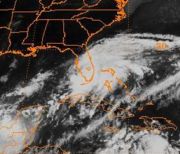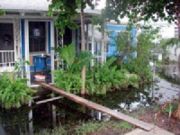Tropical Storm Leslie (2000)
2007 Schools Wikipedia Selection. Related subjects: Storms
| Tropical storm ( SSHS) | ||
|---|---|---|
|
Tropical Storm Leslie off the Florida coast |
||
| Formed | October 4, 2000 | |
| Dissipated | October 7, 2000 | |
| Highest winds |
|
|
| Lowest pressure | 1006 mbar ( hPa) | |
| Damage | $950 million ( 2000 USD) $1 billion ( 2005 USD) |
|
| Fatalities | 3 indirect | |
| Areas affected |
Cuba, Florida, Bermuda, Newfoundland | |
| Part of the 2000 Atlantic hurricane season |
||
Tropical Storm Leslie was a weak tropical storm in October of the 2000 Atlantic hurricane season. Leslie, the 12th named storm of the season, formed out of a trough of low pressure on October 4 to the east of Florida. Initially subtropical, it strengthened to reach winds of 45 mph (70 km/h) before shear weakened it. Leslie dissipated on October 7 over the open Atlantic Ocean, and lasted three more days before losing its identity. The storm had little impact as a tropical cyclone.
The precursor trough of low pressure produced torrential rainfall across Florida, peaking at 17.5 inches (440 mm). The flooding damaged thousands of houses and caused three indirect deaths. Damage in southern Florida totaled to $950 million (2000 USD, $1 billion 2005 USD), of which around half was from agricultural damage. After the flooding, portions of south Florida were declared a disaster area.
Storm History
On September 27, a tropical wave entered the eastern Caribbean Sea, likely the same wave that spawned Hurricane Isaac. It moved generally westward, and remained weak with only sporadic thunderstorm activity. The wave traversed around the periphery of Hurricane Keith, and developed a mid-level circulation just south of western Cuba by October 2. It continued to organize as it moved to the northwest, prompting a Reconnaissance Aircraft into the area. However, the system lacked a surface circulation centre, and remained an elongated trough of low pressure.
The tropical wave interacted with an approaching frontal trough. Its mid-level centre turned to the northeast and made landfall near Sarasota, Florida on October 4. While over land, a surface circulation developed near Orlando, and the National Hurricane Centre designated the system as Subtropical Depression One. The subtropical designation occurred due to deep convection far removed from the centre, as well as an upper level trough instead of an anticyclone providing support for the system.
The subtropical depression moved to the east-northeast, and steadily organized as deep convection developed closer to the center. Peak winds in the system, which were 175 miles (280 km) from the center when it first formed, were only 85 miles (135 km) from the centre by the morning of October 5. Based on its organization and winds of 40 mph (65 km/h), the system was redesignated as Tropical Storm Leslie. As Leslie moved to the east-northeast, it strengthened slightly to reach winds of 45 mph (70 km/h). The storm interacted with an approaching cold front, and became extratropical on October 7 while 375 miles (600 km) north of Bermuda. The extratropical storm accelerated to the northeast and passed over Newfoundland on the 8th. It turned to the east then southeast, strengthening to near hurricane-force winds before losing its identity near Ireland on the 10th.
Preparations
The National Hurricane Centre predicted the trough of low pressure to drop very heavy rainfall across western Cuba and Florida. The National Weather Service in Miami issued a flood watch for southern Florida, stating that the system could produce flooding on roads and low-lying areas. As a pre-emptive measure, water managers moved water out of canals. In general, though, there was little warning for the flooding in Florida. While Leslie was moving east-northeastward, it posed a threat to Bermuda, prompting officials to issue a Tropical Storm Warning. However, the storm passed well to the west, and the warnings were quickly dropped.
Impact
While as a tropical cyclone, Tropical Storm Leslie had little impact, though the precursor disturbance dropped significant rainfall along its path. The rainfall produced severe flooding, damaging thousands of houses and causing heavy agricultural damage.
Western Cuba and Florida
The precursor disturbance dropped heavy rainfall across central and western Cuba, peaking at 8.25 inches (210 mm) in the province of Havana. Numerous other areas reported over 4 inches (100 mm), as well. In southern Florida, the disturbance produced torrential rainfall, including a peak observation of 17.5 inches (440 mm) in South Miami. Two areas, one to the south of Lake Okeechobee and the other being the Miami area, received over 10 inches (255 mm) of rain. The system produced two weak F0 tornadoes in Miami-Dade County, one of which tore off a roof of a fire station in Hialeah.
The torrential rainfall in Florida, similar to Hurricane Irene a year earlier, flooded about 93,000 homes with 214,000 residents in Miami-Dade County. An incomplete damage survey of Miami-Dade County indicated the flooding destroyed 1,005 houses, severely damaged 1,358, and caused minor damage to 3,443. The floodwaters, which were 4 feet (1.2 m) deep in places, also flooded thousands of cars. Many were stranded in their houses, forcing them to use canoes or inflatable rafts to move to higher grounds. All schools in the Miami area were closed, and all nonessential Miami-Dade County employees were asked to stay home. Numerous flights in Miami International Airport were cancelled or delayed, though the airport remained opened. The flooding, which was greatest in Sweetwater, West Miami, Hialeah, Opa-Locka, and Pembroke Park, lasted for up to a week in areas. The extreme flooding damaged electrical stations, leaving more than 27,000 without power. The flooding indirectly killed three people; two from drowning as a result of driving vehicles into deep water, and one when a man fell from a tall building while trying to unclog a roof drain. Property damage totaled to $450 million (2000 USD, $500 million 2005 USD).
Flood waters in Miami-Dade County covered about 40,000 acres (160 sq. km) of agricultural land, causing severe problems for farmers. The flooding occurred at the beginning of the planting period for the winter season. Flooded nurseries and fields resulted in about $500 million (2000 USD, $555 million 2005 USD) in agricultural damage, including $60 million (2000 USD, $66 million 2005 USD) in tropical fruit and $397 million (2000 USD, $440 million 2005 USD) in ornamental crops. The U.S. Department of Agriculture declared 16 Florida counties, including Miami-Dade, Collier, and Palm Beach, as primary disaster areas due to flooding or freeze, making farmers and their families there eligible for USDA emergency farm loans. 22 other counties, including Broward, were also eligible due to their proximity to the disaster areas.
Newfoundland
As an extratropical storm, Leslie produced winds of around 40 mph (65 km/h) while making landfall in Newfoundland. It also produced waves of up to 16 feet (5 m) in height, along with rainfall totals of around 1 inch (30 mm). The overall impact in this region was minor.
Aftermath
In the immediate aftermath, cleanup workers could not work until the floodwaters receded. In addition, abandoned cars blocked the path of utility workers. Following the storm, President Bill Clinton declared Broward, Collier, Miami-Dade and Monroe Counties as disaster areas, allowing for the use of federal funds for the disaster victims. In addition, Miami-Dade and Broward Counties were declared eligible for Federal Infrastructure Assistance, including providing 75% of the debris removal cost and repairing or replacing public roads, buildings, parks, and treatment plants. By 10 days after the storm, government agencies distributed 105,000 meals, 141,000 gallons (534,000 l) of water, and 357,000 pounds (162,000 kg) of ice. Thousands visited five Disaster Recovery Centers, where information on disaster-related issues was given. By around two months after the flooding, over 51,000 applied for federal aid, with assistance totaling to more than $170 million (2000 USD, $189 million 2005 USD).
Because the storm caused little damage as a tropical cyclone, the name Leslie was not retired, and is on the list for the 2006 season.




